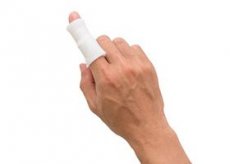Medical expert of the article
New publications
Fractures of the fingers of the hand: causes, symptoms, diagnosis, treatment
Last reviewed: 05.07.2025

All iLive content is medically reviewed or fact checked to ensure as much factual accuracy as possible.
We have strict sourcing guidelines and only link to reputable media sites, academic research institutions and, whenever possible, medically peer reviewed studies. Note that the numbers in parentheses ([1], [2], etc.) are clickable links to these studies.
If you feel that any of our content is inaccurate, out-of-date, or otherwise questionable, please select it and press Ctrl + Enter.

ICD-10 code
- 562.5. Fracture of the thumb.
- 562.6. Fracture of the other finger of the hand.
- 562.7. Multiple fractures of fingers.
What causes broken fingers?
In most cases, finger fractures are the result of a direct mechanism of injury, mainly of a domestic and industrial nature. Under the action of the deep and superficial flexors of the fingers, as well as the lumbrical and interosseous muscles, in fractures of the phalanges of the fingers, a typical displacement of the fragments occurs at an angle open to the back.
Symptoms of a broken finger
There are all the signs of damage to short tubular bones: deformation due to displacement of fragments, swelling and bruising. Pain on palpation. Pathological mobility and crepitus of fragments. Impaired function of the finger and hand.
Treatment of finger fractures
Indications for hospitalization
The hand is an extremely complex organ in its structure and functionality, so any damage to it requires an individual approach, thoughtful, rational treatment at all stages. Fractures of the phalanges of the fingers are classified as severe hand injuries. In outpatient settings, it is permissible to treat fractures without displacement of fragments and single fractures of the phalanges, which after reposition do not give secondary displacements.
The success of treating phalangeal fractures of the fingers depends on careful anatomical alignment of the fragments, complete immobilization in terms of volume and duration, and subsequent complex therapy.
Conservative treatment of finger fractures
3-5 ml of 2% procaine solution is injected into the fracture area. After waiting 5-7 minutes, repositioning is started: traction along the axis, then the finger is bent in all joints to a functionally advantageous position (angle 120°) and the angular deformation is eliminated by pressure from the palmar side. The limb is fixed with a palmar plaster splint from the upper third of the forearm to the heads of the metacarpal bones, and then only the damaged finger is immobilized. Extension in the wrist joint is 30°, the phalanges of the fingers are bent until they touch the opposing first finger, which is approximately 60°. This position achieves the following goals:
- relaxation of the flexor tendons and lumbrical muscles - prevention of secondary displacement;
- optimal tension of the annular ligaments - prevention of contractures;
- in case of complications in the form of persistent contractures or ankylosis in the finger joints, the grasping function of the hand is preserved.
Immobilization of uninjured fingers is considered a surgical error. Equally, an injured finger should not be immobilized in an extended position.
In the first 24 hours after the injury, cold and an elevated position of the limb are prescribed to prevent tissue swelling and reduce pain. Metamizole sodium is indicated internally or parenterally. From the 3rd day, UHF is prescribed to the fracture site and therapeutic exercises for non-immobilized fingers and the elbow joint. The plaster is removed after 3-4 weeks, X-ray control is carried out and restorative treatment begins: warm baths (soda, salt) with exercise therapy in water, ozokerite applications, exercise therapy for the interphalangeal joints, forearm massage, mechanotherapy.
Working capacity is restored within 4-6 weeks.
The treatment period is somewhat shorter for fractures of the terminal phalanges without displacement of fragments and fractures of the sesamoid bones of the hand: immobilization for 2-3 weeks, work capacity is restored after 3-4 weeks.
In case of multiple fractures of the phalanges of the fingers, closed manual reposition is performed and the damaged fingers are fixed with a plaster splint for 3-4 weeks. Labor - after 6-8 weeks.
The skeletal traction method is used in cases where it is impossible to hold the fragments. The limb is fixed with a plaster cast, the same as after reposition, but with a wire hook plastered over the palmar surface. The nail phalanx is anesthetized with 2-3 ml of a 2% procaine solution and a traction device is installed. This can be a silk thread passed through soft tissues or the nail plate, a special pin, thin spokes or staples inserted into the bone of the terminal phalanx. It is good to perform traction by nail plates, to which a layer of polymer resin (AKR-100, steracryl, etc.) is applied with a built-in traction loop. Traction lasts 3 weeks and for another 1-3 weeks the limb is fixed with a removable plaster splint. Labor - in 4-6 weeks.
Surgical treatment of finger fractures
Surgical treatment consists of open reposition and (most often) intraosseous fixation with Kirschner wires. Rigid fixation of fragments is achieved using miniature compression-distraction devices. Immobilization periods: permanent and removable - 2-3 weeks. Labor - after 6-8 weeks.
In case of multiple fractures, restoration of working capacity occurs after 6-8 weeks or more.


 [
[